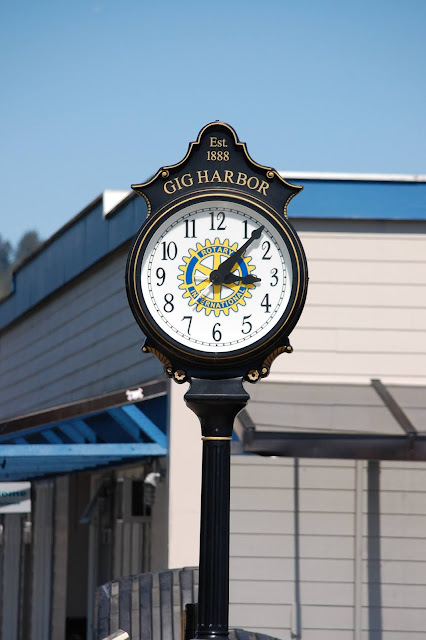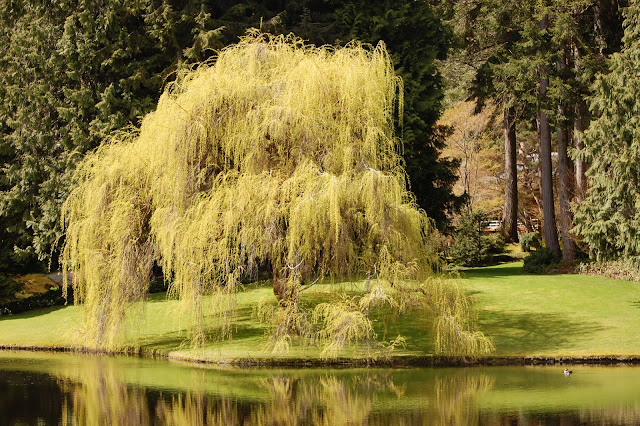Tuesday, April 27, 2021
April 27, 2021 - Attempted Sunrise Pink Moonset
Monday, April 26, 2021
April 26, 2021 - Pink Moonrise Sunset
The rise of tonight's Pink Moon was quite lovely. There are three other super moons in 2021 - March's Super Worm Moon, May's Super Flower Moon and June's Super Strawberry moon.
However, before the moon had her moment, the sun bowed out to the west with a show of her own.
We were lucky enough to catch the first part of the moonrise as it rose between the arms of Everett DuPen's "Vision", a cast bronze sculpture of a diver at the Edmonds Public Library.
Monday, April 19, 2021
April 18, 2021 - A Chamber of Commerce Day
The small harbor town of Gig Harbor, population 7,000, makes for a pleasant scene on this sunny day.
Located on Puget Sound west of Tacoma, it was incorporated in 1946. Prior to the completion of a bridge across Puget Sound at the Tacoma Narrows, Gig Harbor was accessed from Tacoma by ferry. The first Tacoma Narrows Bridge, "Galloping Gertie", collapsed in November 1940 after four months of operations. A replacement bridge wasn't built until 1950. In 2007 a second bridge was added which allows for well over 120,000 vehicles a day to cross Puget Sound here.
April 17, 2021 - Stacked Containers
In random fenced lots south of downtown Seattle shipping containers are stacked eight high. How long have they been there? How long will they be there? Where are the cranes that stacked them? Why is there a tractor trailer on the top of one stack?
Shipping containers were invented in the 1950s in the US to more efficiently load, unload and transport cargo. However, in the 1970s most cargo in the world was still shipped without containers.
Shipping containers come in standardized sizes - TEU (twenty-foot equivalent) and FEU (forty-foot equivalent). They are designed to stack on top of one another and are locked into place on each of the four corners. (The first locking mechanism, still used today was developed in Spokane, Washington.)
While most container ships carry between a few hundred to a thousand TEUs, the largest container ship in the world can carry 12,413 TEUs - an incredible 29 million cubic feet of cargo space!
There are over 55,000 cargo ships in the world today and some twenty million shipping containers. If they were laid end to end they would stretch halfway around the world.
The larger FEU (forty-foot equivalent) containers have grown in popularity and there was a glut of the TEUs around the world as recently as 2020. That changed with the pandemic as the American consumer continued to buy goods. As the need for imports grew, so did the need for shipping containers. The demand in Asia for empty shipping container grew so much that in March of 2020 some companies were focusing resources in getting empty shipping containers back to Asia as quickly as possible. Today nearly 75% of the shipping containers from west coast ports headed to Asia are empty.
Apparently these shipping containers didn't get the word that they are needed.
Thursday, April 15, 2021
April 14, 2021 - Twilight to Downtown Dusk
Milder temperatures make for a pleasant way to pause and watch a cloudless day transform into a gorgeous evening, as the soft pink glow fades and is replaced by the lights of downtown.
Sunday, April 11, 2021
April 10, 2021 - Bloedel Reserve
The 150 acre Bloedel Reserve on Bainbridge Island is considered one of the top botanical gardens in the country. Two miles of well maintained trails take visitors through 23 distinct landscapes including a meadow, woodlands, marshland, glen, moss garden, Japanese garden and a reflecting pool.
The residence, an18th century French inspired design, was built in 1929 as a summer home for a prominent Seattle family. It was purchased by Prentice and Virginia Bloedel in 1951. Born in Bellingham in 1900, Mr. Bloedel attended Yale and went into teaching, but gave it up to join the family timber business.
He was a pioneer in the industry for his recycling innovations including reforestation. In 1938, his firm became the first lumber company to plant seedlings. By 1948 they were responsible for 70% of all reforestation efforts in the private sector in British Columbia.
The reserve has been shaped by a number of noted landscape architects and designers, including Thomas Church, a pioneer in Modernism in landscape design, Richard Haag, who later started the Landscape Architecture Department at the University of Washington and Fujitaro Kubota, who developed Seattle's Kubota Garden.
The property was donated to the University of Washington in 1970. A foundation was later created to purchase and maintain the reserve. Prentice passed away in June of 1996 at the age of 95. His wife, Virginia, passed away in 1989.
The Bloedel Reserve is far from their only legacy to the Seattle area. The Japanese Gardens at the Washington Park Arboretum was made possible by their giving. Their daughter, Virginia, and her husband were top art collectors for decades and have been instrumental in the growth of the Seattle Art Museum.
April 10, 2021 - Scenic Start
The sights from a ferry crossing Puget Sound - the Great Wheel, the Space Needle, the changing skyline, the mountains, the ships and boats - can be at least as scenic as your destination. The excursion this day started aboard the M/V Walla Walla for the 35 minute crossing to Bainbridge Island.
The M/V Sealth heads west to Bremerton, a route that takes it around the southern end of Bainbridge Island.
Tuesday, April 6, 2021
April 6, 2021 - Arboretum Blossoms
This was a fine day to catch the early blooms at Washington Park Arboretum. The 230 acre arboretum is arranged around thematic gardens (Azalea Way, Winter Garden, Rhododendron Glen, etc.) as well as by taxonomic group. The Pacific Connections Garden is one of these thematic gardens. It has plants from Cascadia, China, New Zealand and Chile. The 2.5 acre New Zealand Forest in that garden features 10,000 plants!
The Puget Mill Company owned and logged this land until the late 1890s. While it became Seattle Park in 1900 it was also home to a horse speedway and a sanitary landfill.(?!?!) It was largely undeveloped until after the Arboretum was established in 1934. Currently the Arboretum is jointly managed by the City of Seattle and the University of Washington.
Monday, April 5, 2021
April 5, 2021 - Night Sakura



















































